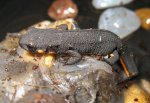stanleyc
Active member
- Joined
- Apr 9, 2009
- Messages
- 292
- Reaction score
- 32
- Points
- 28
- Country
- United States
Now I know that species mixing is generally frowned upon, but I've seen C. Orientalis being mixed with Pyroghaster and they seem to go well together. I was thinking since both Orientalis and Cyanurus are from around the same area in China and are about the same size, if it's possible for them to be kept in the same enclosure successfully. I have 4 C. Orientalis right now in a 20 gallon, and I plan to put either 1 or 2 Cyanurus in there with them.
Can this work as successfully as the Orientalis/Pyroghaster pair, or is even the O/P pair a good idea at all?
Can this work as successfully as the Orientalis/Pyroghaster pair, or is even the O/P pair a good idea at all?

